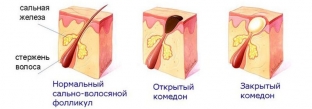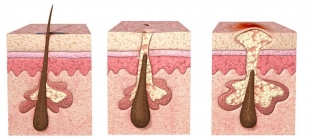Acne has for many years occupied a leading position among the most common dermatological pathologies. On average, about 85-95% of teenagers and 25% of people over 25 experience this problem. An unpleasant dermatological pathology not only significantly worsens the appearance of the patient, but also affects his psychological state. Patients with this problem turn to dermatocosmetologists almost daily, and in order to effectively deal with it, first of all, it is necessary to understand the physiology of the main manifestation of acne – comedones. estet-portal.com has prepared all the necessary information for specialists.
Open and closed comedones: types, causes, prevention
Comedones – this is a type of cyst that is formed when the mouth of the hair follicle is blocked by desquamated skin epithelium along with sebum. They are the main manifestation of acne disease and an extremely unpleasant cosmetic problem.
Comedones appear, often against the background of a violation of the nervous and hormonal regulation of the function of the sebaceous glands.
As a result of increased secretion of sebum with a low content of linoleic acid, which is part of the structure of cell membranes, the processes of keratinization of the squamous epithelium in the upper sections of the hair follicles are disrupted, their mouths are reduced or closed, and the fat stretches the walls of the follicles. This is how a kind of cyst is formed: initially - microcomedones, and then - open and closed comedones.
Comedones:
- types of comedones on the skin: open and closed comedones;
- reasons for the formation of open and closed comedones;
- The main methods for preventing the formation of comedones.
Types of skin comedones: open and closed comedones
The mechanism of formation of open comedones is as follows: in the hair follicles, in addition to sebum, dead epidermal cells, dust, and particles of cosmetics accumulate. They clog the follicle, and at the point where this plug comes to the surface, its upper layer is oxidized under the influence of oxygen, as a result of which it changes its appearance and looks like a black dot. This is exactly what an open comedone is – the least traumatic and dangerous type of comedones. Closed comedones, in turn, remain under the layer of skin, as they have no outlet. They look like small white nodules that rise above the surface of the skin. In closed comedones, inflammatory processes can occur, turning into boils and abscesses, and leaving behind scars and skin irregularities,

Among the main causes that provoke the appearance of open and closed comedones on the skin, we can distinguish:
- hereditary predisposition - individual characteristics of the body, skin type, tendency to excessive production of sebum, pore diameter and others;
- hormonal disorders; pathologies of the nervous and endocrine systems – constant stress, sleep disturbances, diseases of the endocrine glands and so on;
- eating disorders – excessive consumption of fats and carbohydrates, insufficient intake of vitamins and microelements;
- bad habits – smoking, drinking carbonated drinks and alcohol;
- taking certain medications;
- bad environment with excessive content of salt ions of heavy metals, chemicals and other harmful particles in the air;
- prolonged exposure to sunlight, as well as insufficient skin hygiene and improper selection of cosmetics.

As you know, the problem is always much easier to prevent than to treat it later. The same applies to comedones. Among the main methods of prevention of open and closed comedones & nbsp; on the skin can be recommended to the patient:
- washing the skin 1-2 times a day using special cleansers selected according to skin type;
- several times a week exfoliating with scrubs or masks, gels and creams
- containing salicylic acid; application of antibacterial non-alcoholic lotions;
- periodic visits to the beauty parlor for professional care procedures.
Proper skin care and timely visits to a beautician – it is the best prevention of comedone formation on the skin.Only a qualified specialist will be able to individually select the safest and most effective skin care regimen for each patient. Thank you for staying with estet-portal.com.
See also:
"How to fight acne: cosmetic cleansing".







Add a comment